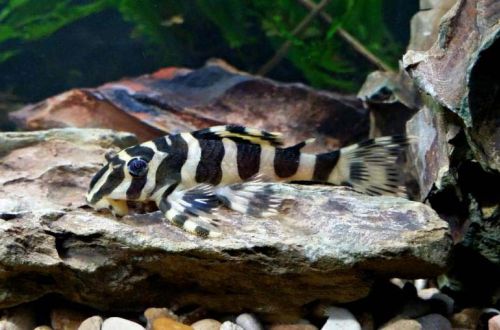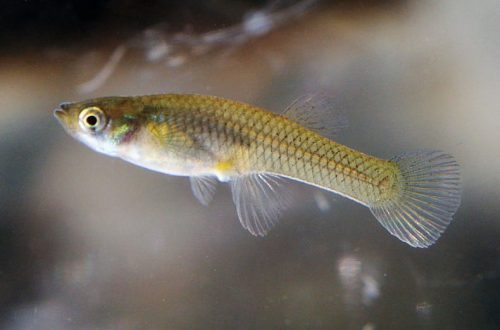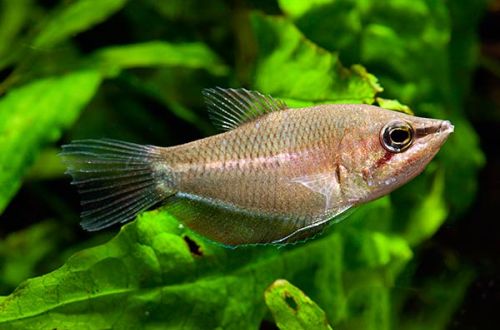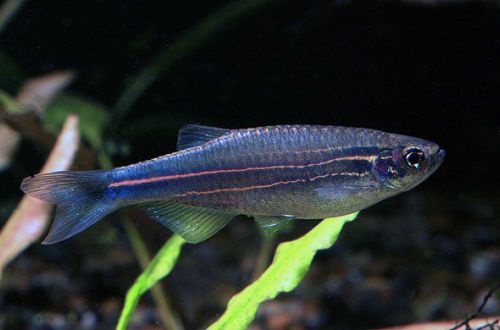
Kerry
The Kerry or Purple Emperor Tetra, scientific name Inpaichthys kerri, belongs to the Characidae family. A miniature fish with an original coloration, this primarily applies to males. Easy to keep, unpretentious, easy to breed. It gets along well with other non-aggressive species of a similar or slightly larger size.
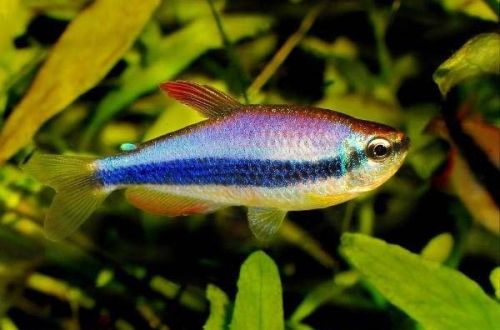
Tse ka Hare
Habitat
It comes from the upper basin of the Madeira River – the largest tributary of the Amazon. It lives in numerous river channels and streams flowing through the rainforest. The water is opaque, very acidic (pH below 6.0), colored light brown due to the high concentration of tannins and other tannins released during the decomposition of organic matter (leaves, branches, tree fragments, etc.).
Lintlha tse khutšoane:
- Bophahamo ba aquarium - ho tloha ho lilithara tse 70.
- Mocheso - 24-27 ° C
- Boleng pH - 5.5-7.0
- Ho thatafala ha metsi - bonolo (1-12 dGH)
- Mofuta oa substrate - lehlabathe
- Lebone - le kokobetse
- Metsi a letsoai - che
- Motsamao oa Metsi - o Tlase / o Itekanetse
- Boholo ba litlhapi bo fihla ho 3.5 cm.
- Lijo - lijo leha e le life
- Boitšoaro - khotso, khutso
- Ho boloka mohlapeng oa bonyane batho ba 8-10
Tlhaloso
Adults reach a length of about 3.5 cm. A wide horizontal dark stripe runs along the body, the color is blue with a purple tint. Males are more brightly colored than females, which often have a modest brown with a yellowish tinge. Due to the similarity in color, they are often confused with the Royal or Imperial Tetra, and the almost identical name adds confusion.
Food
Accepts all types of popular dry, frozen and live foods. A varied diet, such as flakes, granules combined with bloodworms, daphnia, etc., promotes the appearance of brighter colors in the coloration of the fish.
Tlhokomelo le tlhokomelo, tokisetso ea aquarium
A flock of 8-10 fish will require a tank with a volume of at least 70 liters. In the design I use a sandy substrate with numerous shelters in the form of snags or other decorative elements, dense thickets of plants that can grow in dim light. To simulate natural water conditions, dried fallen leaves, oak bark or deciduous tree cones are dipped to the bottom. Over time, the water will turn into a characteristic light brown color. Before placing the leaves in the aquarium, they are pre-washed with running water and soaked in containers until they begin to sink. A filter with a peat-based filter material can enhance the effect.
Another design or its complete absence is quite acceptable – an empty aquarium, however, in such conditions, the Purple Imperial Tetra will quickly turn into a gray nondescript fish, having lost all the brightness of its color.
Maintenance comes down to regular cleaning of the soil from organic waste (excrement, food residue, etc.), replacing leaves, bark, cones, if any, as well as weekly replacement of part of the water (15–20% of the volume) with fresh water.
Boitšoaro le Kamano
Peaceful schooling calm fish. They do not respond well to noisy, overly active neighbors such as Barbs or the African Red-Eyed Tetra. Kerry is perfectly compatible with other South American species, such as small tetras and catfish, Pecilobricon, hatchetfish, as well as rasboras.
This species has an undeserved reputation as “fin clippers”. The Purple Tetra does have a tendency to damage the fins of its tankmates, but this only happens when kept in a small group of up to 5-6 individuals. If you support a large flock, then the behavior changes, the fish begin to interact exclusively with each other.
Ho ikatisa/ Ho tsoalisa
Ponahalo ea Fry e ka khoneha esita le ka aquarium e tloaelehileng, empa palo ea bona e tla ba nyenyane haholo 'me e tla fokotseha letsatsi le leng le le leng haeba e sa fetisetsoe ka tanka e fapaneng ka nako. E le ho eketsa menyetla ea ho phela le ka tsela e itseng ho hlophisa mokhoa oa ho ikatisa (ho hlahisa li-spawning e ne e se ka boomo), ho kgothaletswa ho sebelisa aquarium, moo litlhapi tsa batho ba baholo li behoang nakong ea ho nyalana.
Hangata sena ke sejana se senyenyane se nang le boholo ba lilithara tse ka bang 20. Moqapi o na le boikhethelo, khatiso e kholo ke substrate. E le ho sireletsa mahe hore a se ke a jeoa, tlase e koahetsoe ka letlooa le nang le marang-rang, kapa ka limela tse nang le makhasi a manyenyane kapa moss (mohlala, Java moss). Tsela e 'ngoe ke ho beha lifaha tsa khalase tse nang le bophara ba bonyane 1 cm. Leseli le fokotsehile, heater le sefofane se bonolo sa sefofane se lekane ho tloha lisebelisoa.
Tšusumetso ea ho qaleha ha nako ea ho nyalana ke phetoho ea butle-butle mecheng ea metsi ka har'a aquarium e tloaelehileng ho ea ho litekanyetso tse latelang: pH 5.5-6.5, dH 1-5 mocheso oa hoo e ka bang 26-27°C. Motheo oa lijo e lokela ho ba hoamisoa kapa ho phela lijo.
Sheba ka hloko litlhapi, haufinyane tse ling tsa tsona li tla bonahala li pota-potiloe - tsena ke tse tšehali tse ruruhileng ho tloha caviar. Lokisetsa le ho tlatsa tanka ea ho qhomela ka metsi a tsoang tanka ea sechaba. Beha tse tšehali moo, letsatsing le hlahlamang tse tona tse 'maloa tse khōlō tse shebahalang li tsoteha ka ho fetisisa.
E ntse e emetse ho fihlela ho hlaha, qetello ea eona e ka khethoa ke basali, ba tla "fokotsa" haholo, 'me mahe a tla bonahala har'a limela (tlas'a letlooeng le letle).
Litlhapi lia khutlisoa. Fry e tla hlaha ka hare ho lihora tse 24-48, ka mor'a matsatsi a mang a 3-4 ba tla qala ho sesa ka bolokolohi ho batla lijo. Fepa ka microfeed e khethehileng.
Mafu a litlhapi
E leka-lekaneng aquarium biosystem e nang le maemo a loketseng ke tiiso e molemo ka ho fetisisa khahlanong le ho hlaha ha mafu leha e le afe, ka hona, haeba litlhapi li fetohile boitšoaro, 'mala, matheba a sa tloaelehang le matšoao a mang a hlaha, qala ka ho hlahloba litekanyetso tsa metsi,' me feela u tsoele pele ho ea kalafo.



